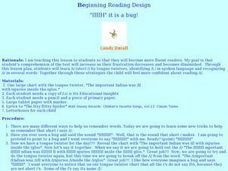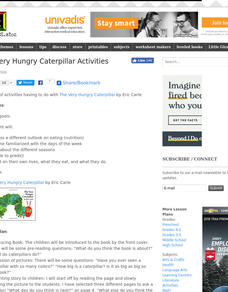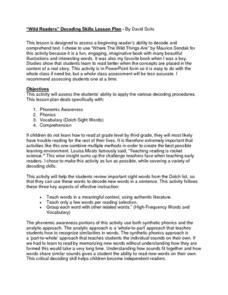Curated OER
Listen Up!
Students explore the short /e/ sound. They practice writing the letter 'e' and making the short /e/ sound. They recite an 'e' tongue twister and practice finding the short /e/ sound in spoken words. They identify pictures of words...
Curated OER
Spinning Short Vowel Game
First graders, in pairs, use spinners to experiment with different combinations of letters. They combine letters and determine whether they have produced a word or not. They construct and record words choosing letters from designated tiles.
Curated OER
"IIIIH" it is a bug!
Students practice the long and short vowel sounds of /i/ in a variety of text with assessing different strategies. They utilize tongue twisters to assist them including "The Itsy Bitsy Spider" and "Liz is Six." Letterboxes are also...
Curated OER
I Scream for Ice Cream!
Students determine that correspondences appear differently in different words. They discover the difference between long and short vowels and that these correspondences are spelled and pronounced differently. They review the i=/i/ and ...
Curated OER
Double Jeopardy-Homophones
Second graders identify homophones as words that sound alike but have different meanings. They, given a pair of homophones, are to explain the meanings of the words using gestures, role playing, or drawing a picture with their partner.
Curated OER
The Very Hungry Caterpillar
Students participate in activities associated with the book, "The Very Hungry Caterpillar". They practice using new vocabulary and the days of the week. They create a book about what they ate on the different days of the week and how the...
Curated OER
First Day of School
Primary learners complete pre reading, writing, during reading, and interdisciplinary activities for the book First Day of School. They will complete journal entries, answer short answer questions, have discussions, and much more.
Curated OER
Ashley's Apples
First graders compare the /a/ sound to that of a baby crying. They practice making the sound and then say the tongue twister as it is written on a sentence strip and then using the overhead and letters, name words with that sound in them.
Curated OER
Abra-kadabra-kazam /a//a//a/, POOF!
First graders discover that each letter of the alphabet has a sound then detect the /a/ sound represented by the letter a. They pretend to be magicians and say, "Abra-kadabra-kazam! POOF!" emphasizing the /a/ sound and then repeat an /a/...
Curated OER
The Fat Cat
Young scholars explore phonemes. They identify that a=/a/. Students recognize /a/ in spoken words by learning a meaningful representation and a letter symbol. Young scholars practice finding /a/ in a variety of words. Students read a...
Curated OER
"Gazunheit!"
Students study the /a/ phoneme by determining how the mouth move when it makes the sound by imitating a sneeze. They recite a tongue twister, practice writing the lowercase "a" and listen to a story while identifying the letter sound....
Curated OER
Baby Sally is Upset Again!
Students, assessing how to read and write, join together grapheme's and the phonemes that make up words. They practice recognizing in oral and written form the vowel /a/. The book, "Matt and Rags," is introduced to the students in this...
Curated OER
A Baby is Crying...Aaa!
Students explore phonemes. They discuss the phoneme /a/ (short a). Students read and write words containing the phoneme /a/. They identify /a/ in written and spoken words. Students recognize the letter symbol for /a/ and find words with...
Curated OER
Bump on the Head
Students discuss as a class if they have ever had a bump on the head and started crying and said /a/. They pretend they have hit their head and say the /a/ stretching it out and try a tongue twister containing the sound and write the...
Curated OER
Aaa, Alligators!!!
Students are introduced to different words that have the /a/ sound in them. They think of their own words that contain the sound and practice making the letter "a" on primary writing paper. Students who have formed the letter correctly...
Curated OER
Adam's Apples
Students examine the /a/ phoneme in both written and spoken words. They practice finding the /a/ in words, watch how their mouths move when making the sound, and write the letter. Next, they differentiate the sound in words, listen to a...
Curated OER
AAA!! The Baby is Crying! AAA!!
First graders take out primary writing paper and review how to form the letter "a". They observe a large picture of a baby crying on the board, discuss it and make the sound a baby makes when it is crying. They listen to some words,...
Curated OER
Beginning Reading Lesson: Aaa-aaa-aaa-choo!!
Pupils study the letter sound recognition for the /a/ by recognizing the sound one makes when they sneeze. They use a chart with a tongue twister on it and work with letterboxes and manipulative letters that focus on words with the /a/....
Curated OER
Casper the Cat
Students examine the letter 'a'. Through instruction and modeling and a variety of practice activities, they explore the sound the letter makes and how the letter is written. They recite tongue twisters, read stories and use letterboxes...
Curated OER
Aaaaa! I um at the Doctor
Students identify and interpret the short vowel sound a = /a/ and the sound aaa. They say a tongue twister together as a class stretching the /a/ at the beginning of the words and identify an illustration to go with each word. Finally,...
Alabama Learning Exchange
Phonics lesson for -ick family
Kindergarteners and first graders develop phonemic awareness for words that contain -ick. Each learner gets a stack of cards with different -ick words, highlighting the target sound as they review each one.
Curated OER
Reading Bugs
Review the phonemic sounds of the alphabet letters before examining how to blend letter sounds to make a word. During this teacher-modeled lesson, learners make word bugs out of three phonemes that blend together. As an assessment, read...
Curated OER
Combining Syllables to Form 2- and 3-Syllable Words
Students practice combining consonant-vowel-consonant sounds to form words. They read closed and silent "e" syllables. Students construct two-syllable words. They arrange syllables to form three and four syllable words.
David Suits
“Wild Readers” Decoding Skills Lesson Plan
Set young readers on the path toward fluency with this phonemic awareness resource. Based on the award-winning children's book, Where the Wild Things Are, this lesson allows beginning readers to practice isolating phonemes and...
Other popular searches
- Long& Short Vowel Sounds
- Teaching Short Vowel Sounds
- Long and Short Vowel Sounds
- Phonics Short Vowel Sounds
- Short Vowel Sounds Together
- Match Short Vowel Sounds
- Esl Short Vowel Sounds
- Identifying Short Vowel Sounds
- Short Vowel Sounds in Words
- Histry Short Vowel Sounds
- Vowels Short Sounds
- His Try Short Vowel Sounds

























